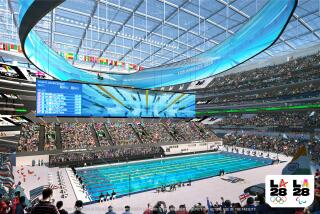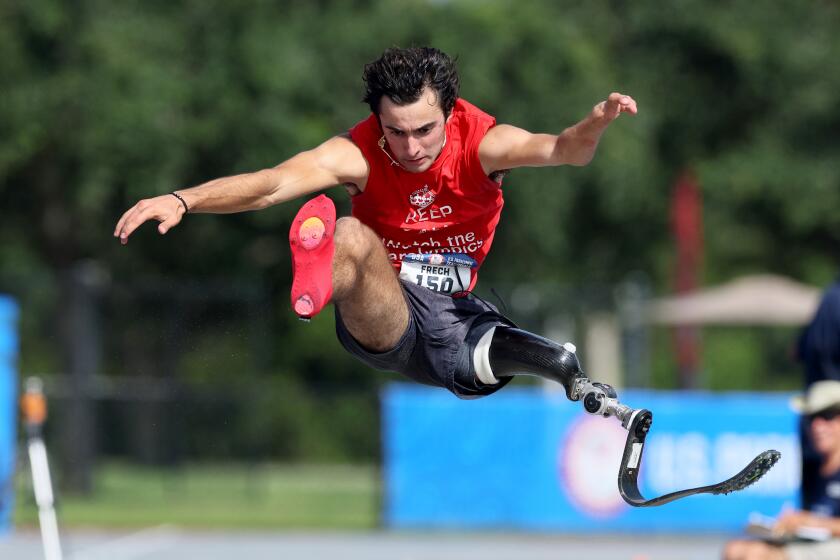Cities Wait Anxiously for Games : Meeting: Four of five who seek to become host for the ’98 Winter Olympics will get bad news today.
Six years after most of them began bidding for the 1998 Winter Olympics, the five finalists were reduced to genuine fear Friday in the last, desperate hours.
Ostersund was running short on reindeer meat, Salt Lake City’s trees were sagging noticeably and the fountain was on the fritz in Aosta’s hospitality suite. Jaca ushered in several hundred schoolchildren to sing “Give Peace A Chance,” sending a fresh wave of panic through its competitors.
The Japanese were doing everything within their power to counter an anti-Nagano backlash that had somehow sprung up.
Seasoned politicians were stunned.
“It’s a different political process than I’ve ever been involved with, I’ll tell you that,” said Utah governor Norman Bangerter.
Mercifully, it won’t last much longer. The International Olympic Committee will select a site for the 1998 Winter Games today in a ceremony at the International Convention Center, bringing to a close its 97th session.
Salt Lake City, Utah; Ostersund, Sweden; and Nagano, Japan, are considered the front-runners, with Jaca, Spain, and Aosta, Italy, lagging far behind. But political and logistic problems make this one of the toughest races to handicap in years.
Does the IOC return to North America for the sixth time since 1976? Does Central Europe deserve the Winter Games for the third consecutive time? Is its expressed desire to expand further into Asia merely lip-service?
Tom Welch, president of the Salt Lake City bid, thinks he knows the answer.
“It’s a case of whether the IOC has the courage to select the best city,” he said. “What I’m saying is, (Salt Lake City) is a city which has been preparing for a long time, building infrastructures and getting ready. We’ve done all we can do.
“This is a great test. I just visited with an IOC member, and he said, ‘We’ll be criticized no matter what we do, so let’s be criticized for making the sound decision.’ ”
But for those IOC voters still unsure, a ring of hospitality suites was set up in the lobby of the Hyatt Hotel. And since a simple majority of the IOC’s 89 voting members is all that’s required to win, every vote counts.
That is why Ostersund plied IOC members with smoked reindeer meat and salmon in a mock Scandinavian kitchen, while Nagano countered with sushi, ornate robes and prodigious quantities of sake.
On Friday, the Japanese organized a huge pro-Nagano demonstration in the square outside the Convention Center, easily offsetting the environmentalist sit-ins earlier in the week.
Salt Lake City imported five dozen fir trees that withered and died as the week went on. But free Western hats, a band with a fiddle and video-cassettes of cowboy films such as “Butch Cassidy and the Sundance Kid” and “The Electric Horseman” got the Western message across.
Candidates spent anywhere from Nagano’s $11 million to Ostersund’s $2.5 million over the last few years, wining and dining the voters, but there is a fine line between lobbying and laying it on too thick. When IOC members found themselves wrestled inside the Nagano suite, seated in front of a high-definition TV screen and given one last, frenzied pitch, this week, a backlash developed.
“We must be careful,” said Sol Yoshida, vice-chairman of the Nagano group, which brought an army of 700 supporters and 250 reporters to town. “But subtlety is difficult for us. We are used to going directly after what we want.”
Bidding for the Winter Olympics has become a tradition for Salt Lake City, whose quest has gripped the city since 1966. The closest it got was in 1973, when Denver defaulted after having been awarded the 1976 Winter Olympics. The U.S. Olympic Committee designated Salt Lake City as a replacement, but the IOC disagreed and chose Innsbruck, Austria.
Salt Lake City’s bid has been impressive. Financed almost entirely by private money, the $4.6-million proposal promises to have all facilities operational by November of 1993, almost five years before the 1998 Games.
Salt Lake City’s greatest problem might not even be its own. Because Atlanta was awarded the 1996 Summer Games only eight months ago, IOC members may be reluctant to return to North America--let alone the United States--again so soon. But Welch is steadfast.
“We have made a commitment to the Olympics in Salt Lake City,” he said.
The Contenders
A quick look at areas bidding to hold the 1998 Winter Olympics:
NAGANO, Japan
The city: 350,000 people in the city and 32,786 in villages near Olympic event areas.
Financing: Nagano expects to break even with revenues and operating costs of $552.2 million.
Facilities: Existing facilities include a cross-country ski course at Hakuba, a freestyle ski area at nearby Iizuna Heights and alpine ski facilities, except downhill and super giant slalom, at Shiga Heights.
Planned or under construction are ski jump, downhill and super-G courses at Hakuba and Shiga and a bobsled-luge track at Iizuna. An ice hockey rink, speed-skating facilities, stadium, Olympic village and press facilities are planned for Nagano.
Experience and Infrastructure: Nagano and Shiga were co-hosts to races in the 1988-89 World Cup ski competition, but never has been host to an event the size of the Olympics. Only a small fraction of the area’s 50,000 hotel rooms meet international standards.
The region’s infrastructure is sound but inadequate for Olympic events and for housing athletes and spectators. By 1998, however, new roads, railroads and airport facilities will have been constructed to improve the transportation infrastructure. Telecommunications are excellent.
SALT LAKE CITY, Utah
The city: 726,000 people in the metropolitan area, with another 66,000 in Park City and Ogden, both Olympic event areas.
Financing: Salt Lake expects the Games to cost $710 million and predicts revenues of $749 million. The construction and maintenance cost of ski jumps, speed-skating rink and bobsled-luge run is set at $56 million from state sales tax receipts accrued over 10 years.
Facilities: Existing sites include a cross-country ski course at Mountain Dell Nordic Ski Area, a freestyle ski area at Park West, alpine ski area at Park City and Deer Valley and downhill and super-G at Snowbasin.
Under construction are ski jumps and bobsled-luge run at Bear Hollow and a speed-skating oval in Salt Lake City. A soon-to-be-completed pro basketball arena is earmarked for ice hockey and figure skating. An existing convention center will house a press center.
Experience and Infrastructure: Salt Lake and environs have been sites for U.S. Figure Skating Championships, America’s opening of the World Cup ski circuit, Men’s Noram downhill and super-G competition and several national championships in gymnastics, fencing and cycling.
The region’s infrastructure includes an international airport, four transcontinental freeways, seven inner highway systems, a bus system, 65,000 hotel rooms in the greater metropolitan area and several first-class hotels in the city center. Telecommunications are excellent.
AOSTA, Italy
The city: 38,000 residents, 76,000 in surrounding resorts. Altitude, 1,900 feet.
Financing: Total costs for staging the games estimated at $655 million. Italian organizers say the expenditure will be entirely covered through broadcasting rights, commercial sponsors and merchandising.
Existing facilities: All tracks and infrastructures for alpine skiing, cross-country and biathlon.
Planned facilities: 10,000-seat ice stadium ($21.4 million); Olympic village ($37.5 million); media center ($32.2 million); ski jumping hills and ceremonies stadium, also to be used for night skiing ($23.6 million).
Experience and infrastructure: Aosta has been host to boxing and soccer matches. Cervinia has held several editions of the world and European bobsled championships.
Courmayeur and Pila have organized races of the World Cup and European Cup alpine ski circuit. Busson and Cogne have held several editions of international cross-country ski events.
Aosta can be reached by highway and rail. It has an airport for tourist planes. The nearest big airports are Turin (60 miles) and Milan and Geneva (105 miles). Hotel rooms are plentiful and the region can accommodate up to 300,000 visitors.
JACA, Spain
The city: 15,000 permanent residents, which swells to 45,000 during summer and winter holiday seasons.
Financing: Revenue estimated at $822 million, with operating costs of $787 million and a surplus of $35 million.
Facilities: Existing facilities include three slalom hills and a training jumping hill. Those being renovated feature a 6,000-seat ice rink and cross-country skiing and biathlon courses. Two downhill courses are in the works. Olympic facilities in the blueprint stage feature a 50,000-seat speed-skating stadium in the main Olympic village complex, a 14,000-seat arena for hockey finals and main venues for ski jumping, bobsled and luge. All events are within a 15.5-mile radius of the city.
Experience: Jaca was host to the 1981 University Winter Games, 12 editions of the World Professional Figure Skating Championships and seven editions of the Pyrenean Games. Spain was host to the 1982 soccer World Cup and will be host to the 1992 Barcelona Olympics.
Infrastructure: Jaca is a 75-minute car ride from airports in Zaragoza, Pamplona and the French town of Pau and is part of Spain’s main rail network. By 1998 it is to be further served by the Paris-to-Madrid high-speed railway line and Valencia-Bordeaux expressway.
OSTERSUND, Sweden
The cities: 60,000 people in Ostersund and 10,000 in Are, Scandinavia’s leading winter sport resort where all Olympic alpine events would be held.
Financing: Total costs for staging the Games are estimated at $485 million. The Swedish parliament has provided financial guarantees of almost $165 million.
Construction costs of new sports facilities in Ostersund total about $165 million.
Facilities: Existing facilities include a 700,000-square-foot main press center in downtown Ostersund, a cross-country ski stadium, one hockey arena and all venues for alpine skiing in Are.
Planned facilities: Two arenas for hockey, figure skating and short-track speed skating (estimated costs: $29 million), one for bobsled and luge ($32 million), ski jumping ($32 million) and a speed skating arena ($6.5 million).
Experience and infrastructure: Both Ostersund and Are have been host to world championships in a majority of the sports on the Winter Olympic program. Are was host to the 1954 World Alpine Ski Championships and has organized 24 World Cup meets since 1969 in alpine and freestyle skiing, including the 1990 World Cup alpine ski finals.
The infrastructure is solid, with a modern international airport 10 minutes from Ostersund’s city center that can handle jumbo jets, rail links to all major Swedish cities.
Source: Associated Press
More to Read
Go beyond the scoreboard
Get the latest on L.A.'s teams in the daily Sports Report newsletter.
You may occasionally receive promotional content from the Los Angeles Times.





